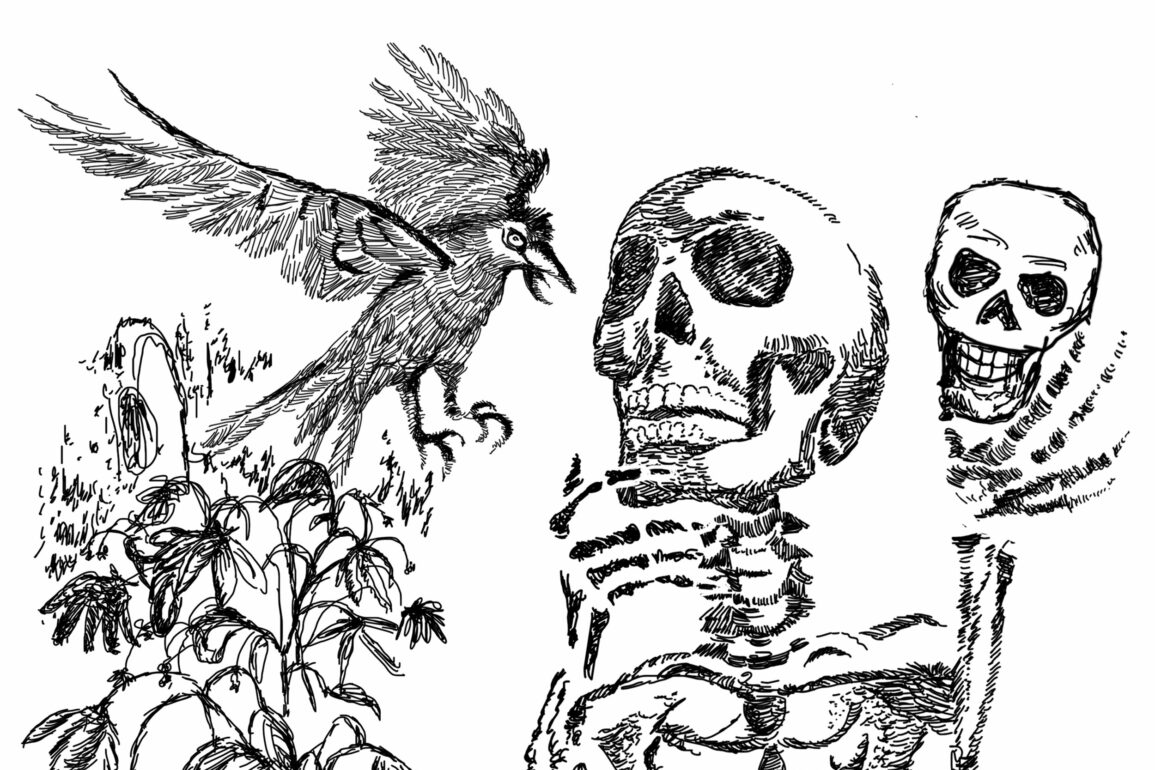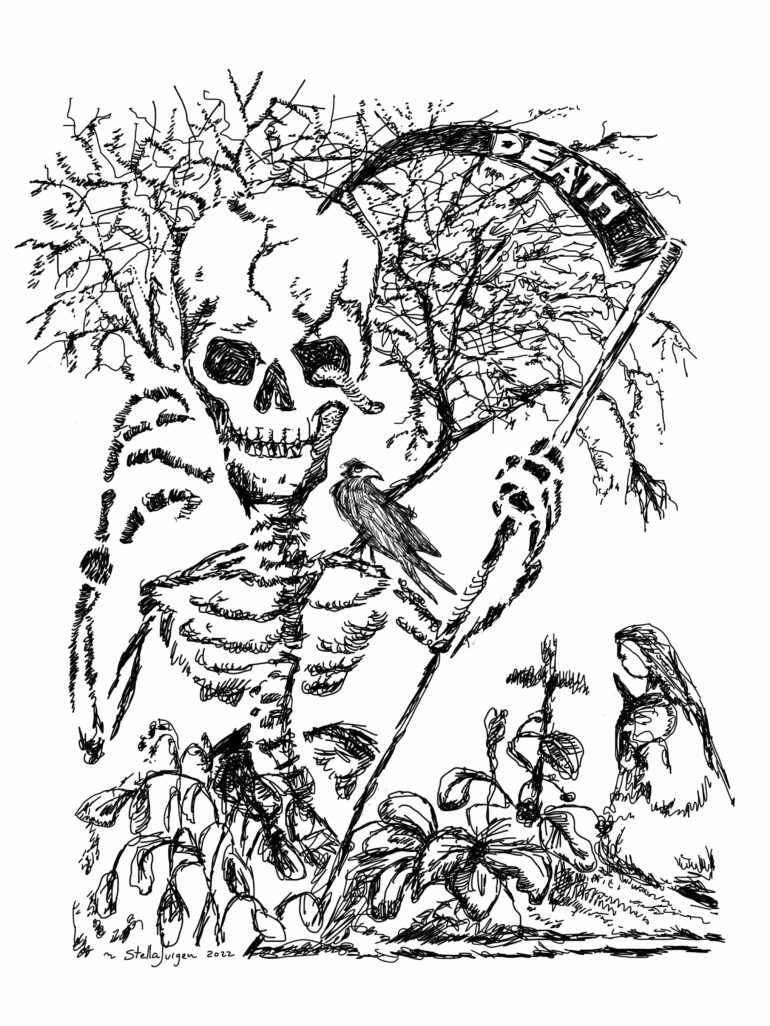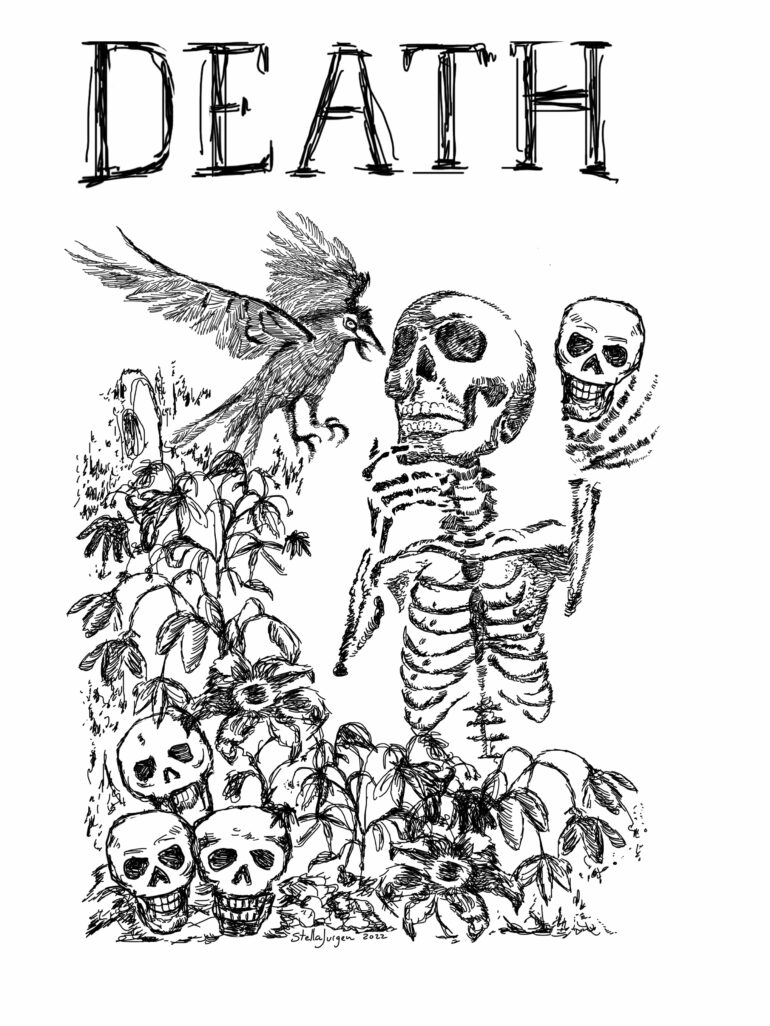As a very young child [way before bubble wrapping children was in vogue], I remember seeing “The Skeleton Dance,” a 1929 cartoon short—the first of Disney’s Silly Symphony series. The film is an interpretation of Danse Macabre [aka Dance of Death]—a symphonic poem by French composer Camille Saint-Saëns based on a medieval legend where Death himself shows up playing lively waltz to escort the living to their graves—kings and commoners, rich and poor, all to face the same fate because we are all connected in death. The Saint-Saëns version has Death in the cemetery, at midnight on Halloween, fiddle in hand playing for the skeletons who crawl out of the ground to dance until the rooster crows at dawn. The skeletons then return to the grave to rest for another year. The Disney version is cheerful and fun, showing four human skeletons dancing while interacting with all the elements we associate with Halloween—the full moon, bats, an owl, cats, a spider, graves and of course, lots of bones. Joyful and upbeat, yes, but five-year-old me was scared to… you know.
Within a year after watching this film, Death himself visited my house taking my father to a very early grave—he didn’t even have the decency to wait until halloween. At 31, he was gone forever—he had reached the ending that no one escapes.
I imagine the next few days were chaotic [understatement of the year?]. I was not consulted on any of the funeral arrangements, but at five, I likely would’ve agreed with whatever was pitched to me. “Mr. David, it seems your father was a great man, who deserves to be sent off in our best solid mahogany casket. Cry if you’d like me to go ahead and process the order.” At this point, I would’ve handed over my [toy] credit card and allowed them to do whatever they thought was “the best thing to do.” Without a “death plan,” which my 31-year-old father did not have—he would constantly joke that he was going to live to be 100—our grieving survivors have a few short days to make a slew of very important (and potentially costly) decisions. Things like choose funeral home, decide whether to cremate or bury, order an urn or tombstone, purchase or rent a casket, obtain a death certificate and burial permit, ask people to eulogize, plan service and maybe a reception, write an obituary, notify your family and friends, let your employer know that you will not be showing up to work… tomorrow [or ever], notify employer and family… and hopefully you’ve given someone passwords to all your online accounts. That doesn’t give a lot of time for your loved ones to research prices. Eventually someone will need to secure the deceased property, forward mail, obtain the will…
Ah death. It’s a sensitive topic… a subject that’s uncomfortable to talk about… one that usually gets locked inside a box and buried underground. Sure, we celebrate death every year, by dressing up as ghouls and ghosts, but the focus is more on our fear of the unknown and our mortality than a day of reflection for the family or friends who have passed. Many of us struggle with having to think about the implication of death [myself included] so we avoid the topic.
For the longest time, in the western world, planning wasn’t a huge issue. Most people were given a church service, then buried in a cemetery nearby—usually the same resting spot of relatives that were long-gone. As time passed, the funeral business became, well, big business because it’s fairly easy to upsell to a person wearing a grief-target on their back. Naturally, you want to give them the best send-off possible, and we all know the only way to do that is to spend lots and lots of money, right?
Wrong. We are in the age of options and just like buying a car, more and more people have started to shop around for a burial that reflects who they were in life. Others are shopping for the best deals because, let’s be honest, many of us can’t afford to die. Just like cars, there are options. “Sure we have the base model but don’t you want air conditioning and sharp looking alloy rims?” I’m not suggesting you take it upon yourself to drive your loved-one’s body to the crematorium [although here in Canada, you’d be legally within your right to do so, as long as you get the right paperwork and ensure the deceased is placed in an enclosed rigid, leak-proof container that is not visible to the public], but since upselling at funeral homes can increase costs by 1000%, some things are worth questioning.
Embalming. This is the process preserving a corpse from decay. We humans have been embalming our dead for thousands of years, most notably the Egyptians did so before mummification to enable the soul to return to the body after death—think King Tut. These ancient techniques involved using spice and plant based concoctions to preserve the body for spiritual reasons. Modern embalming developed as more of a sentimental thing. With people dying further away from home, it was used as a way to preserve the body for travel, to give us a little more time with our deceased friends—when British admiral Lord Nelson was killed in the Battle of Trafalgar, a state funeral was in order, so his body was preserved in brandy mixed with camphor and myrrh for over two months. War, specifically the American Civil War, basically created the undertaker/funeral business and made embalming standard practice—lots of dead bodies that needed to be transported home. The modern process is also quite different, which involves draining all the fluids from the body and replacing them with extremely toxic, carcinogenic chemicals—leaving embalmers susceptible to myeloid leukemia and other rare cancers. This all made sense at the time, but with the advent of refrigeration, is embalming necessary? Depends. If you’re planning to do some Weekend at Bernie’s type of road trip with your deceased buddy, absolutely, if not, the answer is no, it is not. Embalming is expected, because, “it’s always been that way,” and some will, “strongly suggest it,” as a, “safety precaution for the guests,” but that’s just crap. Dead bodies do not cough or sneeze, and any viruses expired wth the body, so they aren’t dangerous at all. You have a better chance of getting sick from the dude who came over to offer his condolences in the form of a full body hug and whisper in your ear.
Caskets have traditionally been another cash-cow for the industry. How fancy do you want to go? We’ve come a long way from the era of the coffin shaped pine-box—highest quality woods, and sealed metal boxes to protect us forever, each costing more than the next. The Ikea bedroom suite may have been fine while he was here, but for eternity, let’s lay him in the bronze casket, with gold plated handles and the Milano eggshell velvet interior, he’d have wanted that. And what about the concrete grave liner we assume has to be there… not so. It may be cemetery policy, but it’s not actually a requirement by law.
One way of avoiding the embalming/casket/burial conversation is by choosing cremation. For a fraction of the cost our remains can be transformed into four to seven pounds of ash and bone dust. WIth cremation on the rise, I can only assume that prospect of saving their families a few shekels while providing them with a souvenir to take home is looked at as a win-win situation—nobody should have to go broke saying goodbye.
Cremation also offers a creative element when deciding what should done with your ashes. The most popular thing to do is simply have them placed in an urn, allowing your family to proudly display them on a shelf in the house, preferably next that bottle scotch you didn’t get a chance to finish. Having your ashes scattered in some of your favourite places is also a popular option, but for the really creative, how about turning your ashes into jewellery, or getting a cremation diamond made? Maybe have an artist mix some of your ashes with paint and commission a portrait or request that a tattoo artist sterilize your ashes and mix them with tattoo ink so that you can get under the skin of your favourite person. Ashes can be concealed inside a cute teddy bear, used as sand inside an hourglass or made into vinyl records—I have a friend who upon reading this may dust off his karaoke tapes from the 80s and press his body into copies of his crackly rendition “La Bamba” backed by his falsetto version of “Girls Just Want to Have Fun” just to torture us from the afterlife. Reef balls are an innovative option. There are companies that will take your cremated remains, mix them into a perforated concrete dome and place that in the ocean to help restore ailing coral reefs. Your dead remains become a living part of the sea, providing structure for fish to swim through, a place for plants to grow and an excuse for your family to take a trip to the beach to visit you. The most spectacular way to go, may be setting your dust into fireworks to be set off at a memorial party in your honour. If you want to take a fireworks show to an epic level, befriend a [very] rich person, instruct them build a giant cannon into a 47-meter monument customized for you, invite 280 of your closest friends, have your rich friend blast your ashes into the heavens, then close the show with a red, white, blue and green fireworks while your friends drink and cheer. Of course, if your name isn’t Hunter S. Thompson and your [very] rich friend isn’t as crazy as Johnny Depp, this option may remain off limits. And then we have good old Keith Richards—this isn’t an option as much as a weird story. According to Keith, he once accidentally spilled some of his father’s ashes on a table and rather than letting them get sucked up into the atmosphere, he mixed them with a little cocaine and sucked it all up his nose—classic Keith.
As “fun” as cremation can be, there is a downside. It’s often marketed as the eco-friendly alternative to burial because compared to a traditional burial it is. In traditional burials, formaldehyde used to preserve the body leeches into the ground and contaminates the land; materials used to make our resting boxes—wood, plastics, metals, fabrics, paints and varnishes—seep poisons into the ground, and create different environmental hazards during their production and transportation. Add to that greenhouse gas emissions from making the concrete needed to build the grave liners, and the fertilizers and pesticides used by cemeteries to maintain their lush green grass and we have a ridiculous amount of prolonged environmental damage. Compared to that, cremation seems like a great option, but it too has environmental effects to consider—the average cremation uses as much energy and creates the same emissions as it does to drive from New York to Chicago.
Eco-friendly options do exist. If you want a casket, there are lots of green alternatives—bio-degradable caskets that turn into mulch, are made out of recycled paper, bamboo, wicker, and even wool. You can have a conservation burial, where the body is wrapped in plain shroud made of natural fibres and placed in a wooded burial preserve—no tomb and no markers, just you getting back to nature. If you’re in a hurry and want to speed up the decomposition process, there’s the Luke Perry option. He went fully organic and was buried in a compostable mushroom suit. Yes a mushroom suit. Basically, this is a burial outfit made out of organic cotton with mushroom spores sewn into the fabric. The spores naturally turn all the body’s poisons and toxins into enzymes assuring your remains won’t contaminate plant life or the water supply. Think of it as turning corpses into compost.
Personally, I’m thinking an aboveground crypt at Cemitério da Lapa in Porto would make a great eternal home… or a spot across from the pyramid that is waiting to entomb Nicolas Cage at St. Louis Cemetery No. 1. in New Orleans—that plot comes with a $40,000 price tag, but just like in life, it’s all about location. Definitely something with a front door that will make it easy to join the other skeletons for the yearly Danse Macabre. Wherever I end up, as a final farewell, and to lighten the mood for everyone watching me being placed into my final resting place, I think I may ask one of my friends to text everyone a final message from my phone, “thanks for coming, see you soon ;-)”
WORDS: DAVID GANHÃO
PHOTO: STELLA JURGEN




